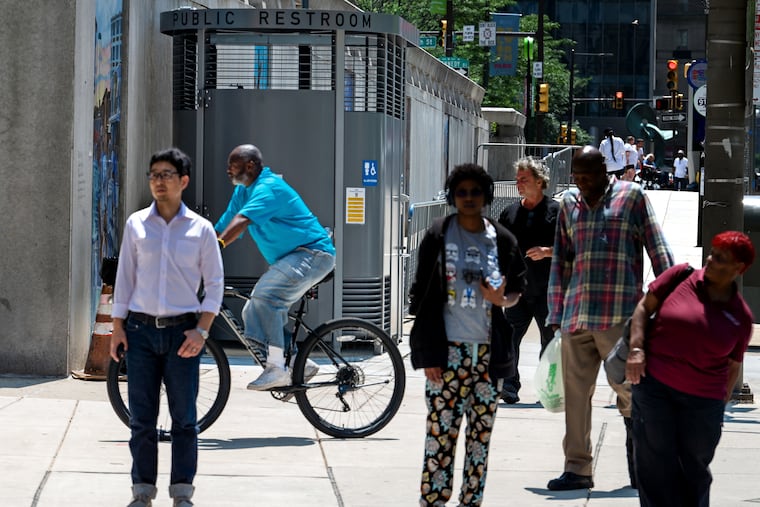Philly’s civic rebound is sure to fall short if the city fails at basic public services | Editorial
Two developments — the closure of the Greyhound bus station and the arrival of new public restrooms — will test whether the city can provide the kind of standard amenities taken for granted elsewhere.

A city can’t be world-class if it fails to provide the basics. While Philadelphia has made great strides in recent decades, it lags in standard services such as public bathrooms and, as of last month, a bus terminal.
So it was welcome relief (pun intended) to see the first public restroom open in Center City this week. The aptly named Phlush is long past due. The stand-alone stainless steel kiosk was first unveiled in Portland, Ore., in 2008. Meanwhile, San Francisco installed the first of 24 self-cleaning public restrooms nearly 30 years ago and just began rolling out a newer version.
Better late than never, Philly. Although the five-year pilot program calls for only six public restrooms across the entire city compared with Portland, which has more than 20 and less than half the population. And already there are problems. Inquirer columnist Stephanie Farr road-tested the Phlush at 15th and Arch Streets and gave it high marks, only to return hours later to find the toilet was clogged.
Philadelphia budgeted $656,864 a year to pay for three restroom specialists to clean and restock toilet paper and other supplies every two hours. If the city fails to maintain the bathrooms, it will literally be money down the drain.
To be sure, many other big cities across the country do not have enough public bathrooms, including New York. This is not a problem exclusive to Philadelphia. The United States has only eight public restrooms per 100,000 people, compared with 56 per 100,000 in Iceland. The U.S. is tied with Botswana in restroom ratio.
Safe and clean public restrooms are a public health necessity in any large city. Philadelphia’s renaissance was built around tourism. But the city can’t lure millions of visitors and not provide for basic bodily functions. The public facilities are also needed as more families and young people move into the city, leading to more vibrant street life.
Most important, public restrooms are a human right that should be available to everyone. In the nation’s poorest big city with more than 4,000 unhoused people, access to public restrooms is also about dignity. More broadly, public restrooms benefit everyone — as anyone who endures a foul-smelling subway entrance knows all too well.
While Philadelphia takes one small step forward by installing a handful of public restrooms, it took a giant step backward when the Greyhound bus station closed in June. Rather than find a real solution, the city allowed bus travelers to congregate along the sidewalk at Sixth and Market Streets.
Inquirer architecture critic Inga Saffron detailed the debacle in a deeply reported column. The Greyhound bus station on Filbert Street was a dingy embarrassment for decades, but it at least provided travelers with access to an enclosed structure with bathrooms and vending machines.
Greyhound has been around for nearly a century and provides low-cost transportation to 1,700 destinations across the county. But Greyhound was sold to a German company in 2021 that then put its bus stations up for sale to better compete with low-cost carriers like Megabus.
Without the stations, Greyhound customers are now left waiting on the curb. What are they to do when it rains or when winter comes? Rather than allow bus companies to operate a curbside business, other cities have built stations and negotiated leases with the carriers.
Philadelphia must do the same. It makes the most sense to build a bus station near 30th Street Station to better connect train and bus passengers. Leaving scores of travelers congregating on the sidewalk with their luggage is a glaring sign of a city that falls short of world-class.